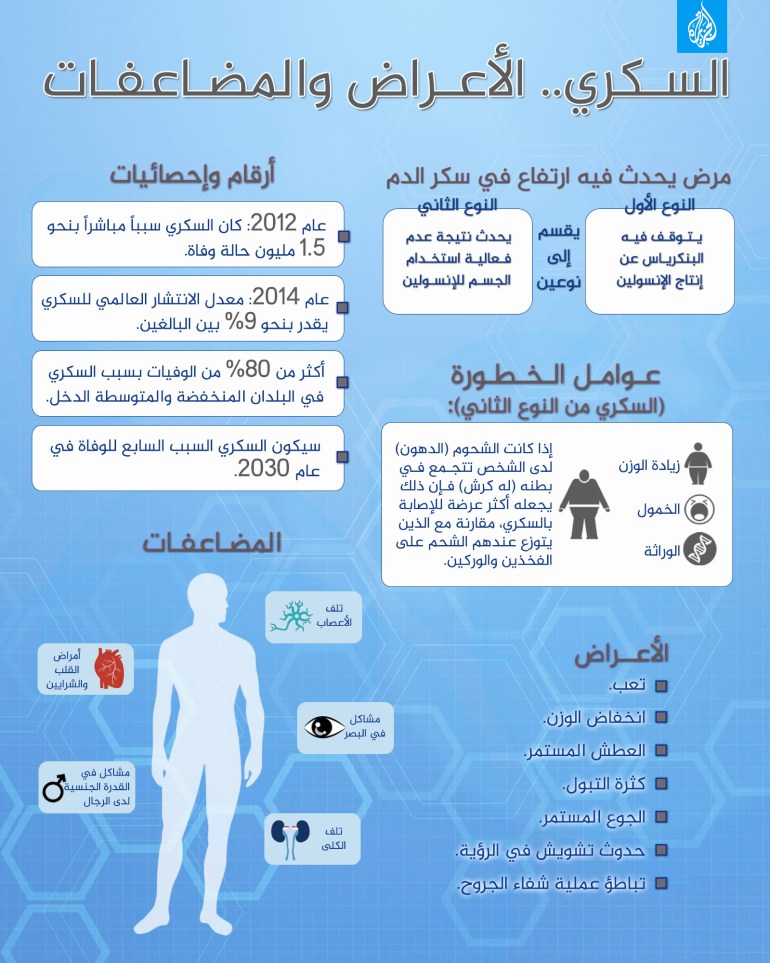What is cumulative blood sugar?
And when should it be measured?
What are its normal levels?
And how can it be reduced without medication?
And when do we need medication?
The answer is in this report.
What is cumulative blood sugar?
Cumulative blood sugar test is one of the tests performed to assess the level of glucose in the blood, in order to diagnose diabetes and evaluate blood sugar control in patients.
The scientific name for the test is the glycated hemoglobin HbA1c, hemoglobin A1c test, also known as the "glycated hemoglobin test".
On the other hand, the name "cumulative blood sugar test" is a common name that indicates that the test measures blood sugar control over a long period (3 months), unlike other blood sugar tests, such as the fasting glucose test, which measures the level of sugar in the blood after 8 hours fasting.
The glycosylated hemoglobin test measures the amount of blood sugar "glucose" that binds to hemoglobin, a protein found in red blood cells.
During the normal 90-day life cycle of a red blood cell, glucose binds faster in people with high blood sugar levels.
The glycosylated hemoglobin test measures the percentage of red blood cells that contain hemoglobin, an important indicator of blood sugar.
Through the test of glycosylated hemoglobin, high levels of sugar in the blood can be detected early, which helps to control it, thus reducing the risk of health complications caused by diabetes, such as heart disease, kidney disease, vision loss and amputation of limbs.
Diabetes is a metabolic disease caused by a lack of the hormone insulin or a weak response of the body's cells to insulin, which enters the sugar in the blood (glucose) into the cells, and in both cases the result is the same, as the levels of glucose in the blood rise above the normal limit, and this leads to negative effects On the body sooner or later.
How long does it take to do it?
The levels of glycosylated hemoglobin should be measured for anyone with diabetes every 3 months, and the test should also be done if the person does not have diabetes but has risk factors for the disease, such as family history, obesity and lack of movement.
What are normal glycosylated hemoglobin levels?
5.6% or less is normal.
From 5.7% to 6.4% pre-diabetes, which is a condition that means that the blood sugar level of the patient is lower than diagnosed with diabetes, but at the same time it is higher than the normal level, and when this condition is not dealt with, the person will develop diabetes from Type II in 10 years or less.
6.5% or higher have diabetes.
If you have been diagnosed with diabetes or pre-diabetes, your doctor will work with you to set an individual target for your glycosylated hemoglobin levels. According to a report published by Insider.
The report says that if you have diabetes or pre-diabetes it is important to lower the level of glycosylated hemoglobin, and in fact, each percentage point reduction in levels of glycosylated hemoglobin can reduce the risk of long-term complications of diabetes by 40%.
How can glycosylated hemoglobin be lowered naturally without medication?
1- Lose weight. Losing extra pounds can help you better control your blood sugar and lower your levels of glycosylated hemoglobin.
Exercise regularly. Exercise helps the body absorb glucose from the bloodstream and can help make the body more efficient at accessing and using glucose.
3- Control your carbohydrate intake. Working with a dietitian to create a nutritional plan can help you lower levels of glycosylated hemoglobin. People with diabetes or pre-diabetes need to monitor their carbohydrate intake, as carbohydrates have a big impact on blood sugar.
Therefore, it is necessary to obtain information from a doctor or dietitian, to understand how eating certain foods affects your blood sugar.
And carbohydrates (starches) are one of the three main food groups that also include fats and proteins, and starches are the most important source of energy for the body.
Carbohydrates are divided according to their chemical composition into:
Simple carbohydrates, such as white sugar, fruit sugar, brown sugar, and sugars naturally found in foods, such as fruits, vegetables, milk and dairy products, and sugars added during food processing and refining.
Complex carbohydrates: such as wholegrain bread and cereal, starchy vegetables, such as potatoes and legumes, bread, rice and pasta.
Complex carbohydrates are better for controlling cumulative blood sugar, and the amount depends on a person's weight, age, gender, activity and glucose levels.
pharmaceutical
If your glycosylated hemoglobin is too high, or in certain cases, or if previous methods haven't lowered it, your doctor may recommend medications, including:
1- Oral diabetes medications (taken by mouth), such as metformin.
2- Insulin. If your initial glycosylated hemoglobin levels are above 9%, your doctor may recommend starting insulin immediately.
Insulin is a hormone that helps the body use glucose for energy. It is produced by the beta cells of the pancreas. Insulin introduces the sugar in the blood (glucose) into the cells.
In the case of using insulin as a treatment, it is injected from special needles, and treatment with it is necessary for everyone with type 1 diabetes and some people with type 2 diabetes, and different types of insulin are available, and they differ in terms of speed and period in which they are effective.

